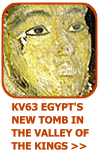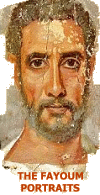|
|
|


The Great Sphinx
The sphinx is without doubt one of the most controversial monuments in Egypt. It evokes huge speculation on a wide range of topics, which often include questions such as the date of its origin, who built it and why? What is its function? There have been various theories expounded in recent times proposing that geological evidence demonstrates that the sphinx was constructed some 9000 years ago. Some of the more controversial theories suggest that it was constructed by a superior race of humans; ie the survivors of Atlantis! To date, none of these dubious theories have been successfully proven.
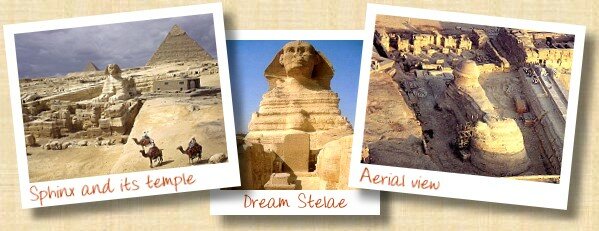
Left: With the pyramid of Khephren as its backdrop, the Sphinx often appears smaller in real life. The ruins in front of it are from the so-called Sphinx Temple. Centre: The "dream stelae" carved by Tuthmosis IV stands between the Sphinx's paws. Right: Seen from above, the temple in front of the Sphinx is clearly visible. In the top right-hand corner, you can just see a small section of Khephren's valley temple too.
Most Egyptologists believe that the sphinx; a fusion of man and lion, was commissioned by the pharaoh Khafre some 4500 years ago, whose identity it is thought to represent-sculpted from the Makkatam Formation, a series of alternating layers of hard and soft limestone. Due to the erosion characteristics of the limestone layers, some sections of the sphinx have eroded more than other sections; consequently, the head is in a better state of preservation than the body, which incorporates elements of both hard and soft limestone. It is this combination of hard and soft limestone that gives the sphinx its distinctive weathered appearance.
Temple ruins
To the front of the sphinx, close to the Valley Temple of Khefren, stand the remains of a temple. The temple appears to have been built of blocks that were quarried from the same rock as the Sphinx, indicating that both were built at approximately the same time. Because of its position, it is clear that it was specifically dedicated to the Great Sphinx, but as it stands, we currently know very little about its actual purpose and use. A lack of any contemporary documentation may perhaps be explained by the fact that the Sphinx Temple was never actually completed - the exterior was unadorned and had no casing. We can only speculate therefore, that It is possible that no priests ever served and no actual cult worship ever took place in this temple.
Dream Stelæ
Between the enormous paws is a stele that records a dream Tuthmosis IV had when he was a prince. He dreamt that he stopped to rest in the shadow of the Sphinx during a hunting expedition in the desert. While asleep, the Sphinx spoke to him, saying that he would become king if he cleared away the sand that all but buried the Sphinx. When he became king, Tuthmosis IV cleared the sand and erected a stele that tells the story of his dream. After the work was completed, a small chapel was built next to the Sphinx to venerate this "sun god".
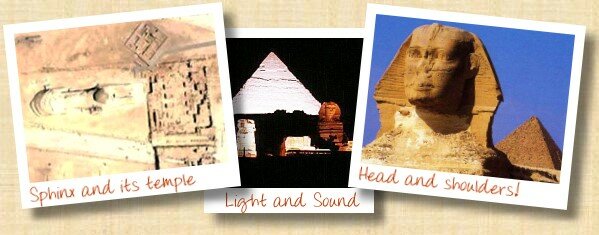
Left: A satellite view of the Sphinx clearly shows the temple that stands before it. Built at an angle to the left of the temple ruins, can be seen the remains of the smaller 18th Dynasty temple. Centre: Light and sound by the Great Sphinx. Right: The head and shoulders of the Sphinx, showing the damage to the nose and remains of the Nemes headdress.
Father of Terror!
To the Ancient Egyptian’s the Sphinx was known as shepsp ankh meaning "Living Statue", which the Greeks later corrupted to the more well known sphinx, meaning "The Strangler". The Arabs knew the monument as Abu-el Hol the "Father of Terror"! We still do not fully understand the inherent symbolism of the Sphinx. The consensus among experts is that it is a representation in stone, of the deified pharaoh Khafre, in his guise as the sun god in Lion form. It acted as a powerful symbol of authority, facing east towards the rejuvenating rays of the dawn sun. As such, Khafre would be symbolically ‘reborn’ every morning, eternally standing guard over his royal necropolis.
When first constructed, the sphinx would have included the royal insignia of a uraeus and a false beard, both painted in vivid colours. Unfortunately, the royal insignia and beard became dislodged and lost during antiquity. However, in recent times, archaeologists discovered a section of the fallen beard, which is now on display in the British Museum. Over the years, controversy has arisen on who removed the nose and some of the mouth, disfiguring the sphinx's face. The finger of guilt pointed to the Mamelukes (1250 AD–1517 AD) and at Napoleon's troops, who are accused of using it as target practice during Napoleon's Egyptian campaign (1798/99). Detective work reveals that the culprit was attributed to a sheik from the 14th century. He thought that the enigmatic smile of the sphinx to be derisive and mocking and ordered the "pagan smile" to be wiped from its face. Evidence found on the sphinx's face suggests that nose and mouth were attacked with chisels or prized off using long iron rods.
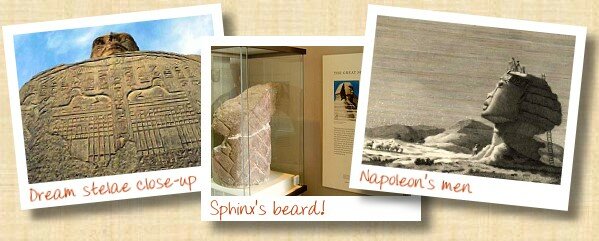
Left: Close-up of Thutmosis IV's dream stelae, that sits between the Sphinx's paws. Centre: Fragment of the Sphinx's beard, now on show at the British Museum. Right: A 19th century engraving showing the French botanist Vivant Denon and his team of "savants" taking measurements of the Great Sphinx.
Conservation
Since 1989, UNESCO has employed a dedicated team of forty full time artisans who are continually counteracting the effects of weathering and pollution. Their task is monumental as the sphinx's head is in danger of collapsing due to the corrosive effects of pollution, which has reduced the thickness of the neck by several inches making the head increasingly unstable. It is hoped that with todays technology a solution will be found, saving this ancient monument from further deterioration.
Next site: Saqqara >>
|
|
|






